*sponsored in part by Far North Rentals and Okopako Lodge*
On the morning that I left Paihia, I did so with no plans and only one accommodation booked: an evening at the Okopako Lodge deep in the Waima Forest outside Opononi. I drove recklessly with abandon to destinations far and wide across the Northland district and I explored whatever took my fancy. I took recommendations from everyone and I traipsed barefoot through more brush than ever before.
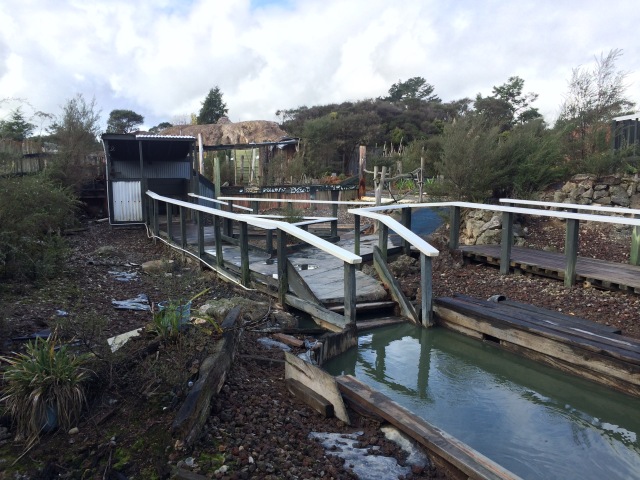
I left on a particularly cloudy day. My writer friend tells me that I shouldn’t begin a story with the weather but since I have started most of my stories with the weather, I may as well keep going. It also serves to explain to you that while I didn’t really feel like leaving Paihia – it had become safe, comfortable, like a staid relationship you just can’t walk away from – at least the weather wasn’t great enough to make me stay.
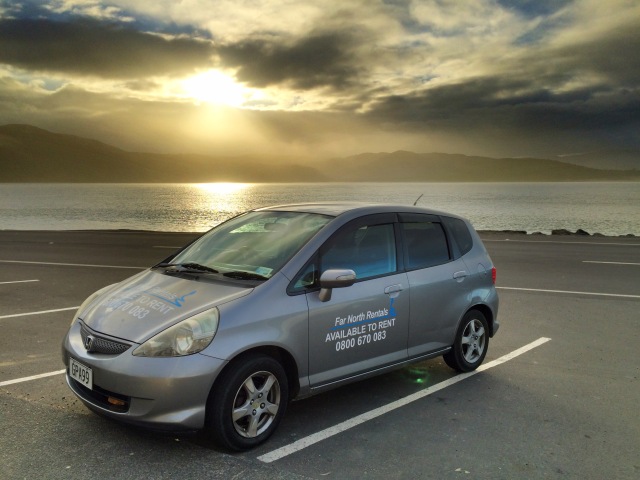
Bob, from Far North Rentals, had dropped my car off the day before and I’d packed it to the brim with my backpack, cheap duffel, and computer bag. Then I’d added my food crate, my cooler bag, some wine, a leftover pair of running shoes, a crap pillow, and my tagalong bag of laundry powder. I left my dead car sitting in the parking lot of the hostel and roared off in a shower of gravel dust. Not that there was anyone to see me go, of course. I was the last one. The Holdout.
My first stop was a place I’d been trying to get to for ages, a place my bar regulars had told me about: Ngawha Springs. Now, if you know me, you know I like hot pools. Natural ones, not man-made hot tubs. And Ngawha Springs is about as natural as they get. It’s not pretty, not at all. The ramshackle office was manned by a lone man who quietly took my $4 with the merest hint of a smile. I slipped into the changing room and donned my bikini then walked down the wooden paths to the pools.
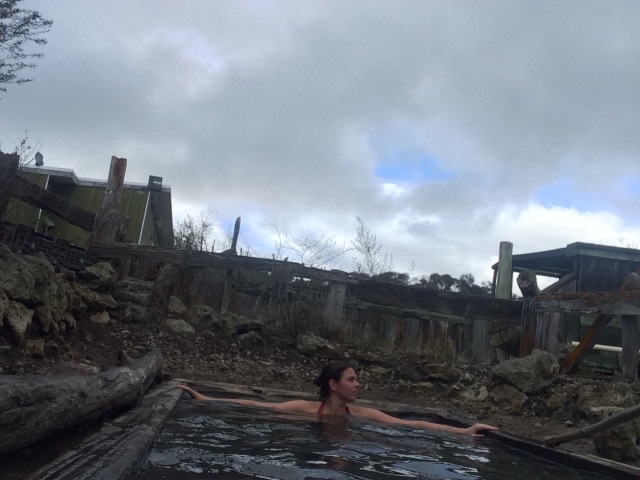
It’s not glamourous – it’s not even attractive – a 3 on a scale of 1 to 10, maybe. Like, you want to give it a shot but you’re not sure if you’ll catch something. The pools – there are seven or eight of them – are a dark blue, almost black, or a sludgy brown. They’re surrounded by fencing and minimal landscaping. In places, canvas tarps cover dirt piles or unused pools. Plastic pallets make up some of the walls. There’s a ton of character, not glamour.
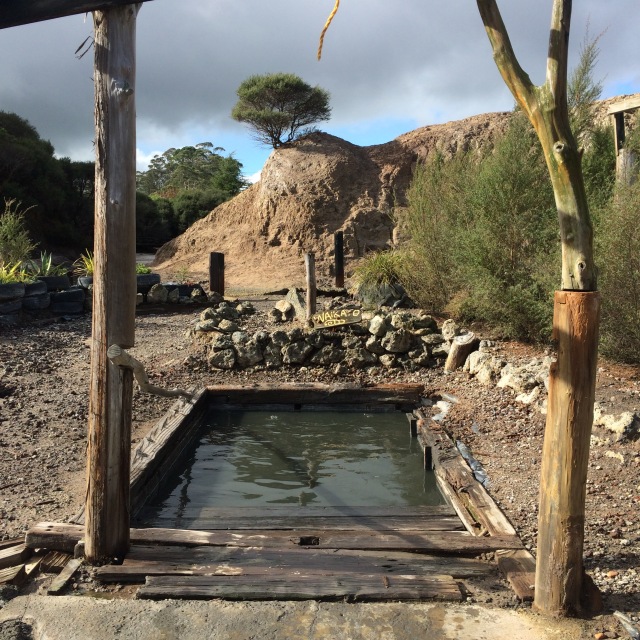
For all this, I was smitten. The pools are hot – none cooler than 25 degrees – and the wooden boards are soft underneath your feet. I sank into the pools with relief; a summer of working at a bar, sunning by the bay, and bicycling around town had my muscles sore, even if I didn’t know it.
I ended up chatting with several sisters who were there. English both of them, one now lives near Ngawha and was showing her sister around the area. She gave me some recommendations for food and coffee along my route and we talked about travel, about work, and about how we ended up in New Zealand. There were very few people at the pools: myself, the two English women, three young Germans, two local Kiwis, and two Aucklanders. A lone man came in while I was on my way out and several Japanese tourists came in, looked around, and left again. The English Kiwi woman told me that the local Maori believe the springs to be healing waters, and many of them come several times a week to sit and soak in the powerful waters.
I’m not saying I believe it, but I feel a lot healthier since my visit.
I was reminded of the Blue Lagoon, in Iceland. When I visited there, it was after a short hop from Boston and I was beyond exhausted. I paid the cheapest admission (easily over $40 USD, not including luggage storage or a towel) and all that got me was admission to the pool and some relaxation space. Not that Ngawha had “extras,” per se, but $4 NZD is $2.50 USD. To sit at a hot spring for as long as I feel like, under billowing clouds, while surrounded by native plants. The crowds at the Blue Lagoon were plentiful; too many as the day went on. I spent probably four hours there, soaking, putting silica on my skin, soaking some more, having a nap in the relaxation space, and finally catching the bus to Reykjavik. On the flip side, the crowd at Ngawha could have been contained in one square metre pool having a delightful conversation about the Northland.
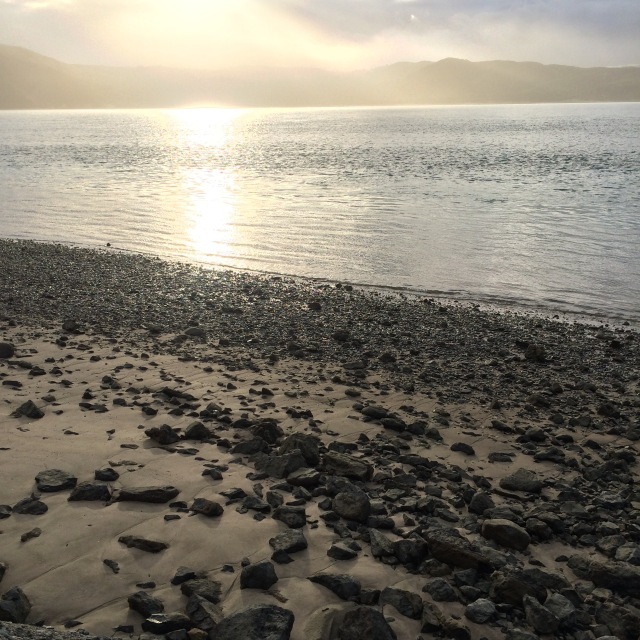
After leaving Ngawha, I drove to the lookout point at Hone Heke Reserve. It was pouring down rain at this point, so I ate lunch in my car and then drove into Kaikohe for a coffee (recommended by the Englishwoman.) A mere hour later, the sun was out in full force and the hills at Rawene were pale golden in the late afternoon sun. I turned off on to Mountain Road and wound my way to the Okopako Lodge. I was greeted first by Ruff, a grey mop of a dog who latched his front paws around my leg and held on tight. Lois was right behind him, a white-haired woman with a quick smile and bright blue eyes. She showed me into the lodge: the spacious, airy lounge and kitchen – both of which overlook the hills below – and my room, a comfy bed with cozy blankets and a thick, (perfect,) pillow.
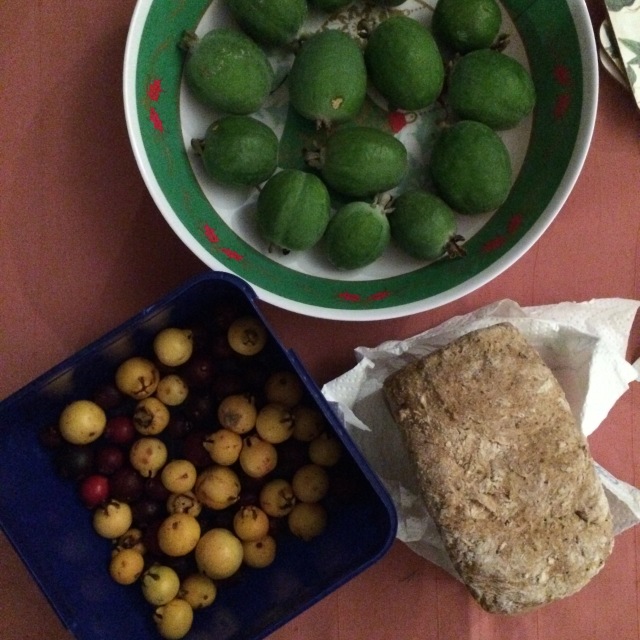
When I asked about the lookout point at the harbour entrance, she nodded and gave me precise directions. She also picked out a leaflet on Hokianga and recommended a few places for the following day. As I was putting my groceries in the fridge, Lois pointed out the feijoas on the table and told me to help myself; she also said she would bring me some cherry guavas later.
The lookout point was everything I could have wanted in a lookout point: no one else around, stunning sunset over the sand dunes, breaking waves against the boulders below, sandstone cliffs with manuka trees, windy paths with gorgeous views at every turn…. I could go on and on. I was in awe. I never wanted to leave. I did not want to pick my feet up anymore and walk back to my car.
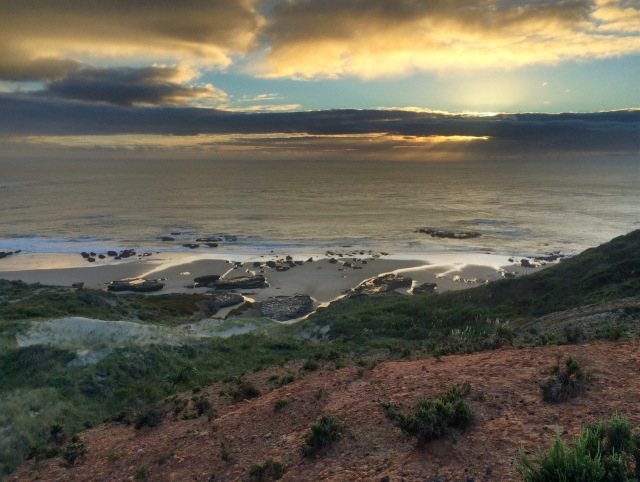
As the sun set and the clouds rolled in, the cliffs were bathed in darkness. Finally, I turned back and headed to the carpark. I slowly drove back through Omapere, Opononi, and along Mountain Road. I was still the sole guest at the Lodge and I made myself at home: dinner, a book, my computer. Lois brought in the promised cherry guavas, a tart treat for post dinner, and some freshly baked bread. She asked if I would be interested in feeding the sheep in the morning, and of course I said yes. As darkness fully descended across the hills, I shut my computer and stepped outside. The clouds that permeated the skies earlier in the day were scattered across the stars, giving me tantalising glimpses of the heavens – and one lone pink star. As I star gazed, my thoughts drifted to the next day.
In the morning, I awoke with the sun and threw on my hiking shoes. I let myself out of the gate and turned up the road. I climbed higher and higher along the gravel track. To my left, the hill dropped into the valley; to my right, the trees ascended in a tangle of ferns, birch, and rimu trees.
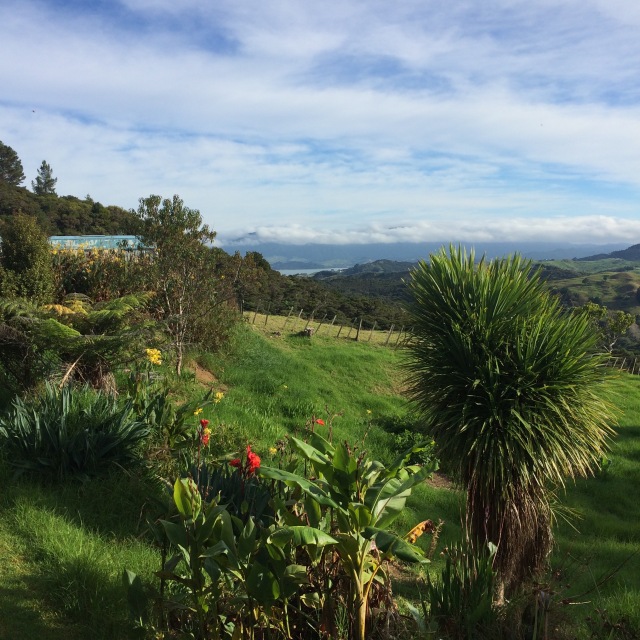
When I got back to the lodge, I tossed the cherry guavas into my granola and yogurt. They popped in my mouth like tart gooseberries. The bread Lois baked was hearty and still warm (my imagination?) After breakfast and my shower, I shoved on my hiking shoes and walked down to the farmhouse. I wanted to know if the road through the Waimamaku Gorge was sealed or unsealed. While I was chatting to Nils and his son-in-law, Lois asked me if I still wanted to see the sheep. I did, so I said goodbye to the men and we walked up into the paddock. We fed them a mixture of cherry guavas and sheep food and Lois told me about the different kinds they have. My favourite were the little ones running around with undocked tails – so long and fluffy that they dragged along the wet grass. Several were shorn, but Lois said that’s only because they are supposed to be self-shearing (I wasn’t too sure if she was maybe pulling my leg, so I looked this up. They’re totally a thing – they are Wiltshire sheep that self-shed) and didn’t shed as much as Nils would have liked so he sheared (shore?) them.
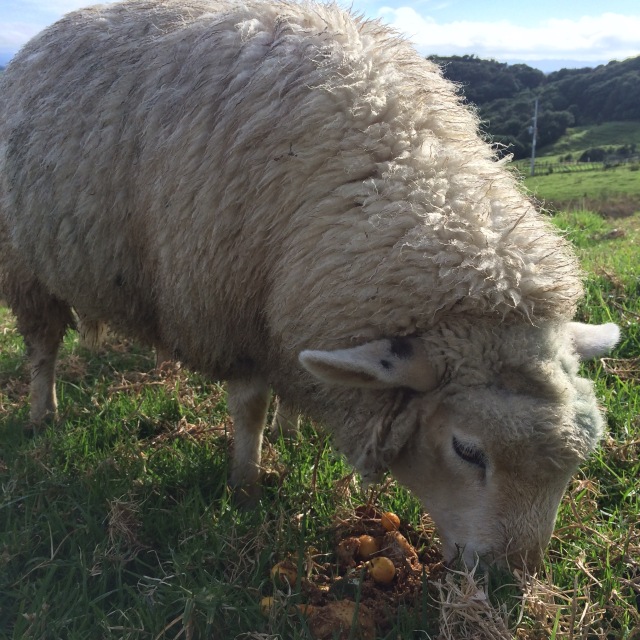
I was able to get close enough to pet some of the sheep – Minty and Minnie for two, ones that Lois bottle-fed – and at least a couple were curious about me. After that, I said goodbye to Lois and Nils and drove back down Mountain Road. I stopped in Omapere for a coffee and made my way into the Waipoua Forest.
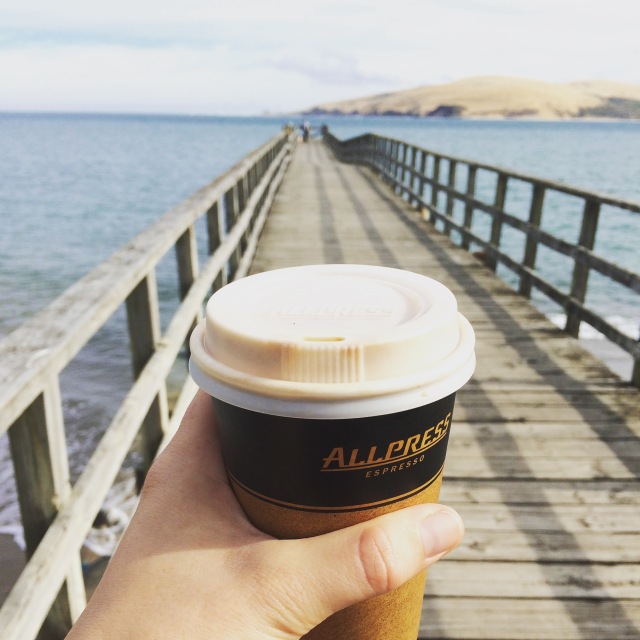
Here, I was struck by the beauty of the trees. Their height. Their boldness. And I was struck by the fact that this road is less traveled. I don’t know another person that has driven it; I was all alone on it. Lois’s husband, Nils, told me that this road used to be the main highway. It’s a narrow, at times one lane, gravel road. I find it hard to believe that, but stranger things have happened here in New Zealand.
I was on my way to the Labyrinth, a woodworking puzzle shop that Lois recommends, and for that matter, I do too, if you happen to be there when they are open. The Rough Guide NZ also recommends it: they open up when you honk your horn. Unfortunately, they were closed. The craftsman was at the dentist, the handwritten note on the door told me. I sighed, unable to stick around for an extra four hours. Instead, I wandered out to a nearby waterfall, deep in the forest. I saw two other people. The ferns were damp with the dew even late in the morning, which reminded me again and again, this is a rainforest.
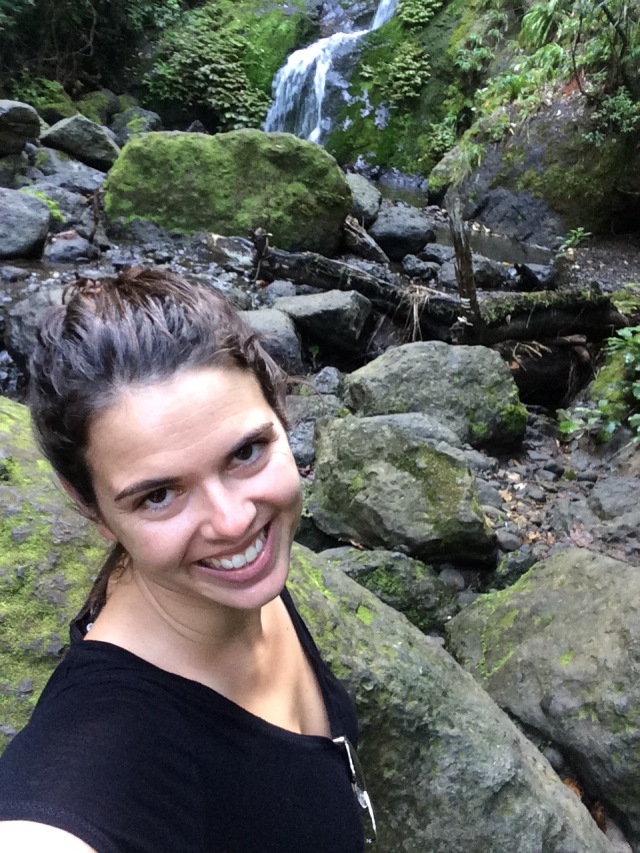
I returned the way I came – down the narrow gravel road out to the state highway. Within minutes, I drove straight into a fairy tale forest. Tall pines, trees shooting straight into the sky. The forest deepened and suddenly I came upon a sign for the Big Kauri Tree: Tane Mahuta. For such a large tourist destination (pardon the pun) there is not a lot of parking. I slipped into a spot and climb out of my car. I looked both ways and crossed to the boardwalk, where I wiped my feet in sanitiser before walking into the forest. Kauri dieback disease is a real thing, and you only have to see the dead kauris to realise that it’s happening at a faster rate than normal. There is a huge movement up here in the north to protect the kauris by cleaning gear before and after walks and by not stepping on kauri roots. For more information, you can visit the kauri dieback website.
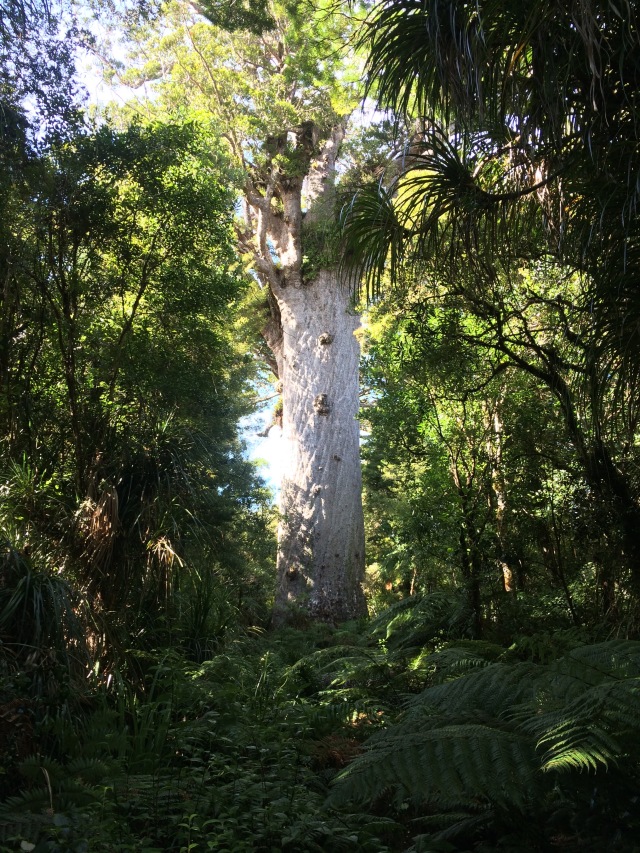
Two kilometres up the road is the Kauri walks, several trails that branch off toward Yakas, the 7th oldest kauri, the Four Sisters, and Te Matua Ngahere, the 2nd oldest kauri. I crossed paths here with two girls who posed for pictures wearing a unicorn head. Silly, but it brought a smile to my face. We chatted briefly and then they left me to my musings. After a while, I returned to the main path and to my car. I had a couple of questions for the parking attendant – my hope was that the DoC would employ a parking attendant that could also answer any questions about the kauri trees and I was not disappointed: he whipped out a book about the kauri forest and we browsed it looking for my answers. In short, what I had thought about the kauris was true: they are essentially their own ecosystem. I had wondered about that because I kept seeing ferns and lichen growing high up in the trees – I wondered, how can the kauri support this external life system? It all has to do with the soil that kauri grow in and the way that they are “recyclers” of the forest. If you are interested – and you should be, because kauri are very fantastic ecosystems – you should read this page on kauri forest ecosystems.
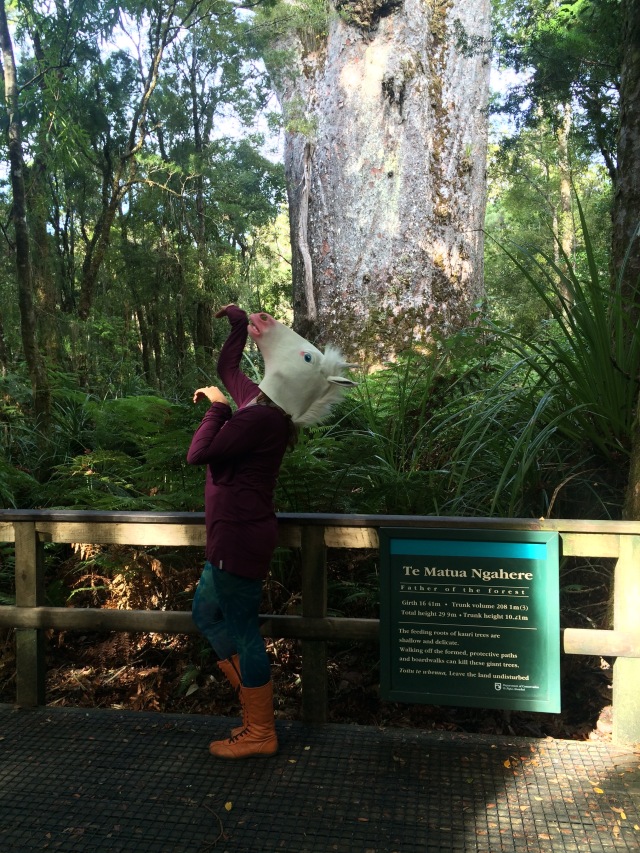
I left the kauris to their peaceful forest and drove further south; once again, I was the only car on the road… and lucky too, because the road was narrow and wound its way around cliffside so close to the road that I was sure an oncoming car would knock me right into the mountain. But all too soon I was climbing the hill out of the forest. The rolling green hills around me reminded me instantly of the farmed hills in western Pennsylvania, or Ireland, or Ohio. The landscape changed abruptly: from rough forest to delineated farmland. It was a harsh change, and it signalled something to me.
I was no longer in the north.
The views got broader – rolling green hills with livestock, delineated fields, farm trucks. No longer were the side roads unsealed. I took a detour to the Kai Iwi lakes – farther north, the 11km road would have been completely unsealed – instead, it’s a quick drive out along a two lane sealed road to the bright blue lakes with sandy beaches. The cliffs on one side of me were a chalky white; the brush on the other side a pale greenish brown, dead from the summer sun.
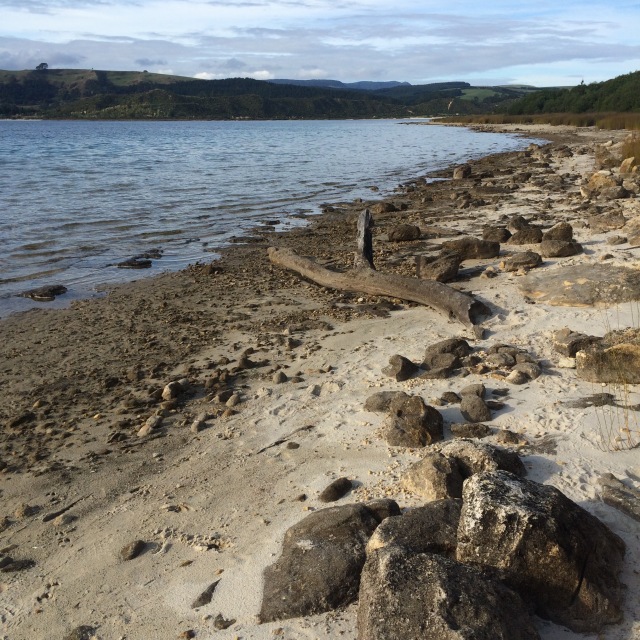
Oh, for sure, I was still *technically* in the north of New Zealand… but for all intents and purposes I was now in cultivated land. No longer did the creeks run wild, the trees grow to abandon, the sun duck behind the evergreen hills. Here, it slipped down over emerald farmland, over judgmental cows, over the sand dunes, to the western sea.
I turned back east at Dargaville; my destination was near Whangarei. I was sad to leave the west coast – I knew I had to come back. Evening came quickly and it was dark by the time I got to Rob’s.
The following morning, I headed back north: I was off to explore Abbey Caves, just outside Whangarei, and the Tutukaka Coast. Most specifically, the mermaid pools. My first stop, after a coffee, was the caves. In retrospect, this was stupid, and I realised that soon after arriving. The caves are not necessarily unsafe, but there is a big sign at the entrance stating that they are undeveloped. Enter at your own risk.
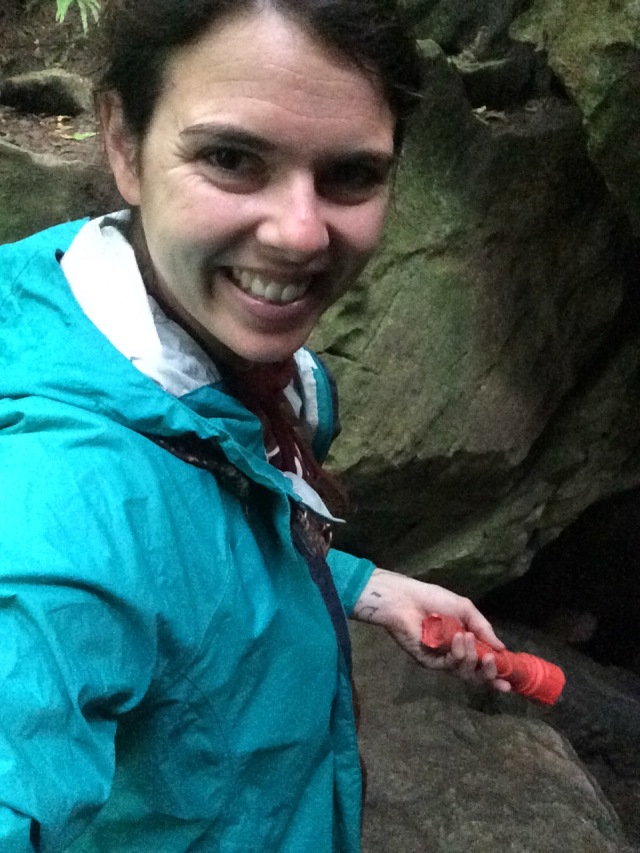
I had sturdy shoes and a torch, but no helmet, no line, nothing else. I hiked down to the first cave and had a poke around. Organ Cave is the largest, while Middle and Ivy Caves are smaller and narrower. These two are also the only ones in which you can enter and exit at different points. I only found the entrances. As I said above, it was probably really stupid of me to be out there alone, with no gear. I crawled into the entrances of each cave but could hear water in each of them and wisely decided not to go further. I later found out that when friends of mine did it, they were up to their waist in mucky water. No thank you. (I’ll do it later.)
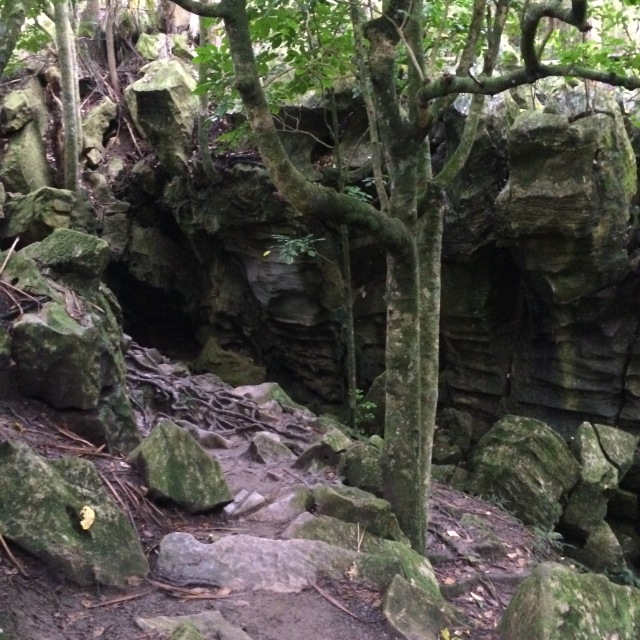
The land was originally homesteaded by the Clotworthy family in the 1860s. The house, which resembled an Irish abbey, leading to the name, burned down in 1920 but a chimney remains as well as the grave of one of their children from 1884. I did not find either one. The limestone outcroppings here are fantastic, though. It is amazing to me that nature can create such shapes. And they look as though they were placed there gently by some giant. It’s beautiful. It’s definitely on my list of places to go back to before leaving NZ.
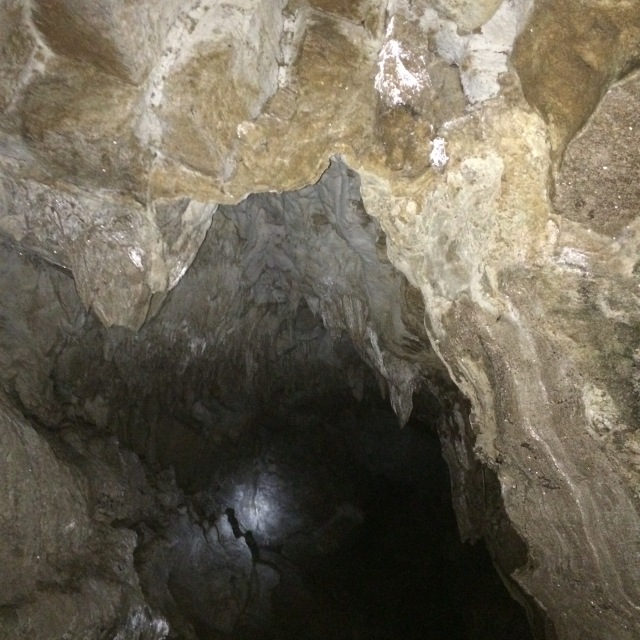
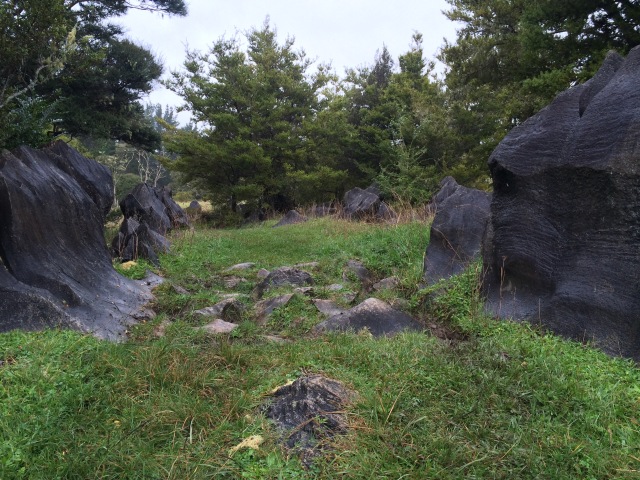

My next stop was the Tutukaka coast, specifically Matapouri Bay. I arrived soon after high tide so I made some lunch and read my book while waiting for the tide to recede a bit. The trek to the Mermaid Pools is exhausting, but completely worth it. It must happen during the tide recession or you’ll get stuck out there.

These pools should be on the must-do list of anyone on the Tutukaka coast.
I began my hike by walking along the wide beach toward the far headland. I clambered over a small outcropping – the water being still too deep to walk – and along the next tiny beach. Climbed over another headland. The trail begins here – a narrow pathway up a steep hillside. Due to the rains over the previous week, the trail was slippery, the tree roots being what held me to the hill. I was barefoot – it would have been much harder in shoes – and for every step I took, I slipped back a little bit. About halfway up the hill, thin rope was strung between the branches to assist trekkers. At the top of this thin trail I entered a palm tree grove. The trail went higher still and plateaued among the trees. Ferns lay scattered across the ground, evidence of high winds. Then the trail exits the trees to a rocky coastal view.
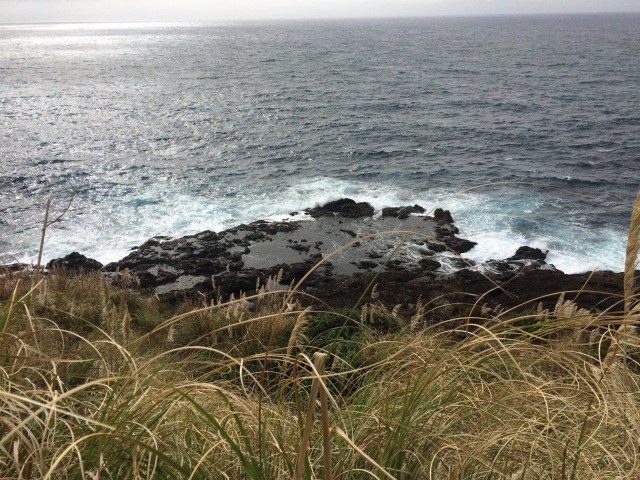
I began to walk downhill through the scrub. Below me, the pools were an iridescent blue green. High tide still crashed over the rocks into the pools, sending sprays of white water high into the sky. I shed my clothes and slipped into one of the pools. It was cold but calm. I was the only person there. I lay on the rocks for a time letting the water lap over my legs. The pools are probably awesome in the summer, when its hot and sunny… that day was cloudy, rainy, and a bit cold. But – still worth every moment of it. I could see a heavy storm coming in and so I dressed and began the long walk back up over the headland to the beach. At the car, I changed into dry clothes and crawled into the car. I followed signs for Whale Bay but did not walk down there; in hindsight, I should have. It’s a gorgeous view from the top of the hill though!
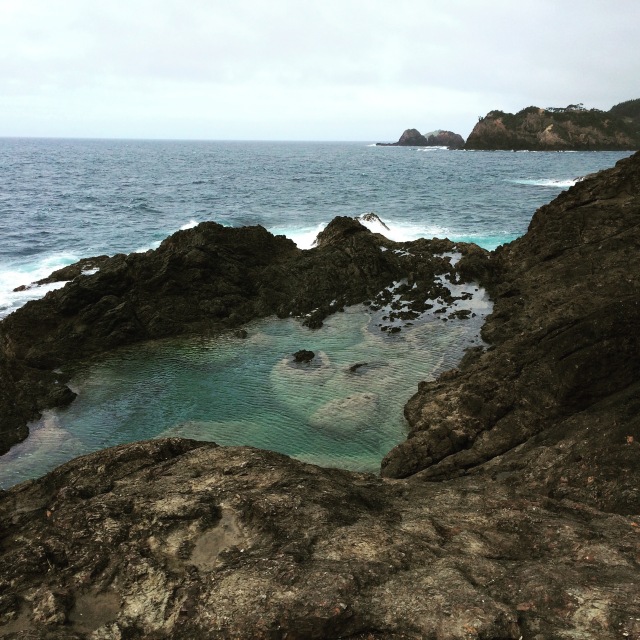
It was halfway through my Northland road trip and I was only a mere hour from where I started. What else was I going to do over the next few days? Stay tuned for a far north road trip: part two, coming next week!


5 thoughts on “a far north road trip: part one”
Comments are closed.